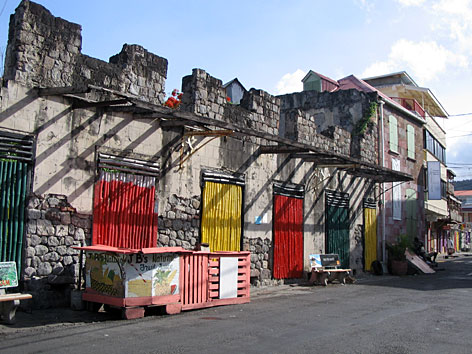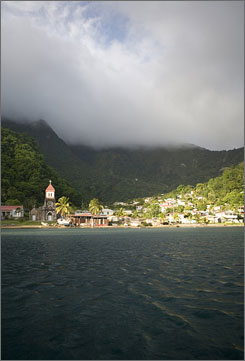Volume No. 2 Issue No. 7 - Monday July 16, 2007
The Old Ways Still Dominate in Dominica
 Jayne Clark, USA TODAY Jayne Clark, USA TODAY

 ROSEAU, Dominica � On this eastern Caribbean island, a mountain lake roils in a volcanic cauldron. The sea spews shimmering bubbles that flutter underwater like diamonds. And rain pours while the sun shines. ROSEAU, Dominica � On this eastern Caribbean island, a mountain lake roils in a volcanic cauldron. The sea spews shimmering bubbles that flutter underwater like diamonds. And rain pours while the sun shines.
The island's natural lushness has a surreal quality. Even its darker place names � Boiling Lake, Valley of Desolation, Massacre � have their charms.
Yet despite its singular qualities, Dominica (pronounced "Dom-in-EEK-a") has dodged the cross hairs of mass tourism. At least so far. Hollywood came calling recently, first with the filming of the Pirates of the Caribbean movie trilogy, then as the venue for the current CBS reality show Pirate Master.
Fortunately for travelers who prefer a Caribbean experience minus sprawling resorts and manufactured tourist attractions, not even pirates � or Hollywood's version of them, anyway � can plunder this island of its essential nature. Because on Dominica, nature rules.
Its coast is wild. Its interior sprouts a claustrophobia-inducing tangle of foliage. It harbors secret places. No wonder this verdant island was a favorite among early pirates seeking a little R&R between pillages. And no wonder its natural attributes made an ideal backdrop for current pirate-themed productions.
About a third of its 300 square miles consists of nationally protected land, much of it in the rugged interior highlands. It boasts 365 rivers, spectacular waterfalls, a resident pod of sperm whales, some of the Caribbean's top dive sites and the highest concentration (eight) of potentially active volcanoes anywhere.
As a result, Dominica attracts a different sort of visitor from the rum-punch-swilling, duty-free-shopping, beach-novel-reading layabout � or at least when the cruise ships aren't in port.
And though tourism is the nation's No. 1 industry, it's still in its infancy. Officials plan to keep it low-key by targeting niche markets, namely hikers, divers and birders.
What vacationers won't find on this laid-back mountainous island: chain hotels, timeshare condos, all-inclusive resorts, golf courses. (The balls would just roll into the ocean, quips one resident.)
Even its most glaring deficiencies � the lack of ample air service and a dearth of sandy beaches � have in ways spared Dominica the fate of some of its overdeveloped neighbors.
"It all comes back to the environment. There's no way to construct a (jumbo) jet airport without cutting down a mountain," says Dominican-born anthropologist Lennox Honychurch. "So the people who come to Dominica really want to come here."
Getting here does require effort. There are no non-stop flights from the USA, and connection schedules can require overnighting en route. (A runway expansion expected to be completed in late 2008 will enable night landings, which should help.) There are no non-stop flights from the USA, and connection schedules can require overnighting en route. (A runway expansion expected to be completed in late 2008 will enable night landings, which should help.)
Dominica also lacks the sweeping white-sand beaches that are the siren song of many Caribbean islands. Which matters not one whit to visitors like Jim Pettigrew, an oceanographer from San Francisco.
He has hiked a 45-minute trail through a forest of platter-sized leaves, pastel wild impatiens and hot-pink ginger lilies to Middleham Falls in Morne Trois Pitons National Park, Dominica's UNESCO World Heritage Site. The water cascades 200 feet off a sheer cliff, forming a pristine pool in the forest. It is a marvel, and he and his companions have it all to themselves.
Pettigrew has visited every Caribbean island and lived in Jamaica as a boy, so he has some basis for comparison when he says: "There are few islands in the Caribbean like this. It reminds me of how Jamaica was 30 years ago.
It's the lack of big resorts. The intactness of the coral reefs. The intactness of the forests. It has a healthy natural infrastructure. If you go somewhere where the land is denuded, the people are dispirited."
Indeed, the locals seem vested in their island and fiercely protect it. Compared with more tourist-hardened Caribbean spots where the hustle can be relentless, Dominica is a gentle spirit.
Even in the markets of Roseau, the capital and only town of note, vendors are strictly soft-sell. The absence of international franchises means more room for small, homegrown enterprises. Lodging is primarily in small hotels and guesthouses. The names of small businesses reflect pride of ownership � Judd's Snackette, Woody's Pizza, Flossie's Market.
The island has the highest percentage of individual land ownership in the Caribbean, a condition that Honychurch credits, in part, to the early collapse of the plantation system in the mid-19th century.
It failed for the same reason other ventures did: The geography, terrain and nature itself were just too formidable. Consequently, Dominica was the last Caribbean island to be colonized. The British and French volleyed possession before the British ultimately claimed it in 1805. The island gained independence in 1978.
On a cliff top overlooking Prince Rupert Bay on the island's northwest corner, Honychurch is overseeing the resurrection of an 18th-century officers' quarters, one of dozens of garrison buildings swallowed by the foliage in what is now part of Cabrits National Park.
He strolls beneath the forest canopy to the stone foundation of a house in ruins. The Pirate Master crew filled it with water and tied boa constrictors to tree branches for a treasure-hunting challenge, he says.
Though the obstacles were less contrived in colonial times, they were no less daunting. Besides the rough terrain, the aboriginal Carib Indians were warlike; as Europeans colonized the Caribbean, Caribs from various islands flocked to Dominica.
Now the region's sole group of Caribs numbers about 4,000, most of whom occupy villages within a 3,700-acre reserve on Dominica's northeast side.
Last year, the community opened Kalinago Barana Aute (Carib Village by the Sea in the native tongue) to showcase its cultural heritage. Here, Caribs weave and sell their distinctive two-toned larouma reed baskets, stage occasional gatherings and chat with visitors about their history.
The site has sparked renewed interest among the Caribs in their native foods, dances and language, says manager Kevin Dangleben.
"It's an opportunity to right some wrongs," he says. "It sends the message to people here that there's something significant about them. If you can get people to appreciate what's unique about them, then their cultural heritage is in good hands."
Dominica was also rich in pirate history long before Johnny Depp and the Pirates crew breezed in. Sir Francis Drake, Sir John Hawkins and other luminaries of piratedom were here. Dominica, so late to be colonized, was an ideal hideout for pirates to clean and repair their ships and trade with the Caribs for fruit, says Honychurch.
Today, there's scant reference to the historic marauders, save for the Pirates Duty Free shop, with loot from Gucci and Dior, near the cruise ship dock in Roseau. Cruise traffic to the island has ballooned in recent years. About 270,000 passengers annually stream off 200 to 250 ships versus only 85,000 overnight visitors.
"The challenge is to keep it (tourism) contained," says tourism minister Yvor Nassief. "Keep it niche, but with enough critical mass that locals can make a living."
The Hollywood exposure has helped increase awareness of Dominica's prodigious natural attributes, he adds. These days, guides point out Pirates film sites on the Indian River, at Titou Gorge and in the Carib Territory, among others. But few islanders seem wowed by Hollywood's power.
"People who come from the States are excited about (the film locales). But Dominicans aren't impressed," says Sonia James, a transplant from Germany. "It's just a different mentality."
E-mail [email protected]
|
|





